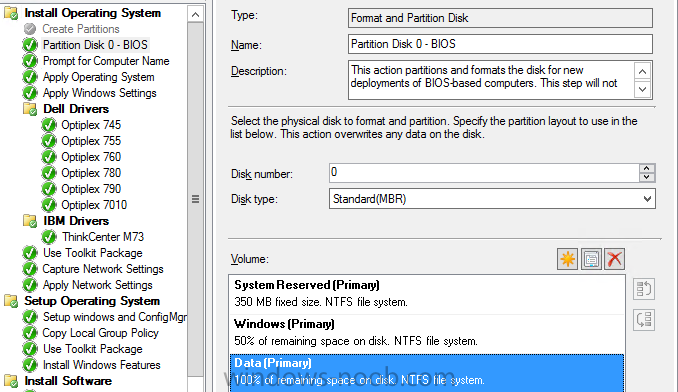Search the Community
Showing results for tags 'diskpart'.
-
I have a laptop that has Disk 0 and Disk 1. Disk 1 is my D drive. Disk 0 is my issue. It is setup like this: OS C; 990 MB healthy recovery partition. 1.4GB healthy recover partition. My issue is I can't wipe out the Two recovery partitions. I want one huge 3GB drive. I don't need the recover partitions. Using Disk Management I can't delete them or partition them. Using Diskpart I can see the Volumes but both are Hidden and I can't Unhide them. I've googled this and I've tried doing detail partition and set id = 07 override and nothing works. how do I Unhide them so I can format them and use the space?
-
Morning all, I’ve been looking at an issue for the last couple of days that has me somewhat confused. I know there have been other posts regarding this but I’ve not yet seen a definitive reason behind it… We have a small number of systems in the environment that have two physical drives for example a 75GB and a 300GB drive, meaning the preferred setup would be: Disk 0 (75GB) 200 MB: System reserved 50GB: OSDisk 24GB: Data Partition Disk 1 (300GB) 300GB: Extra Can someone please explain why in Win PE these disk randomly swap between Disk 0 and Disk 1?? I need to ensure that in a system refresh scenario these desktops only ever have W7 Enterprise installed to Disk 0 (in the example above) thus leaving Disk 1 alone. We are using the OSPart task sequence variable at the apply OS Phase so I am going to try to use the following script that I believe Niall had a hand in creating in order to target the current partition that has Windows installed: <job id="GetDriveletter"> <script language="VBScript" src="..\ZTIUtility.vbs"/> <script language="VBScript"> dim driveSearch Set objFSO = CreateObject("Scripting.FileSystemObject") Set colDrives = objFSO.Drives For Each objDrive in colDrives driveSearch = objDrive.DriveLetter & ":\\Windows\\explorer.exe" strComputer = "." Set objWMIService = GetObject("winmgmts:" _ & "{impersonationLevel=impersonate}!\\" & strComputer & "\root\cimv2") Set colFiles = _ objWMIService.ExecQuery("Select * From CIM_DataFile Where Name = '" & driveSearch & "'") If colFiles.Count < 1 Then Else oEnvironment.Item("OSPART") = objDrive.DriveLetter & ":" End If Next </script> </job> I would still very much like some insight as to why the Disk numbers change at what seems to be random intervals….is it a hardware issue i.e. symptom of using SATA drives, or that OSD prefers the larger drive.... Thanks. Rich.
-
Secondart Partition and Drive Letter Assignment
Epitome posted a topic in Configuration Manager 2012
Hi guys, After developing my OSD process for my work and creating all my WIMs, the IT manager decided that it would be better for us to install the SCCM client and cache into a secondary partition in a hidden folder. Reason for this is we use DeepFreeze and the cache/config is getting wiped at thaw time and is causing problems with Windows Updates. I understand why, but it's creating quite a difficulty to implement. After a few hours of investigation I thought I had a solution. In the "Format and Partition Disk" step of the TS I have a 60GB Primary partition (SCCM Partition) created with no drive letter assigned, then the remaining disk space used for OSDisk. I did this because it was assigning C to the SCCM partition and wanted to install the OS to it. I thought if I used a diskpart command utilizing a txt file to assign M (the letter we settled on) to partition 1 of disk 0 (which is what diskpart told me it was) before the "Setup Windows and Configuration Manager" step, there would be an M drive for SCCM to install to, as per the installation properties I set, namely: smscachesize=40960 smscachedir="M:\SCCM\cache" ccminstalldir="M:\SCCM\client" I am getting no failures in the TS, and in fact nothing in the log files shows any failure except the normal ones you'll see regularly. The diskpart step is completing properly according to the smsts.log file. However, for some reason once the system finishes imaging there is no M drive, SCCM isn't installed and as a result none of the UDI-chosen software is installed either. There is no CCM folder anywhere to be found. The partition is visible in Disk Management, but has no drive letter assigned and if I assign it M there is no data in it. I'm really surprised that the step to install the client finishes without error and clearly didn't work. Thing is, I can't get a log file after that point to check because, once again, the SCCM files are nowhere to be found. I know I could do this by completely redoing the WIM I based everything off of, but that would take several days of work, and I'm about to leave on vacation for a week. Below are screencaps of the steps in question and a copy of the simply diskpart.txt file I'm using. Help please! diskpart.txt -
I work for a college and we have a windows 8 OS pre-existing in my lab. Those machines are frozen by DeepFreeze. I want to deploy another windows 8 OS to the same machines which will make them dual boot. We were using Ghost before and were able to do this by creating a separate partition and applying the OS to that partition. We moved to SCCM infrastructure recently and when I tried to accomplish this through the task sequence, the existing image get wiped out. Please help me with this.
-
As the title suggests: I'm looking for guidance on how to wipe the MBR via Task Sequence during an OSD. Any suggestions? We use Symantec Encryption Desktop (aka PGP) and it adds a bootguard to the MBR which needs to be cleared out (we need to wipe the MBR) in order for the machines to boot successfully. If I boot a Win8.1 amd64 ISO, select Repair > Advanced > Command Prompt > Run bootrec.exe /fixmbr, it works fine and corrects the issue so I thought "Why not add bootrec to our amd64 WinPE.wim?" I copied what I thought were the necessary files into our amd64 winpe.wim, based on the following sites: https://channel9.msdn.com/forums/TechOff/456721-Windows-PE-with-BOOTRECEXE/ http://gregwoods.co.uk/2010/04/creating-a-winpe-boot-dvd-for-disk-cloning/ http://www.audiodude.nl/?p=1217 I even pulled in the MUI's from WinSxS into the WIM And although it appears to run successfully, it executes and produces no errors, it doesn't seem to actually be doing anything as the problem persists on a reboot. Running bootrec /fixmbr and/or bootrec /fixboot multiple times in our amd64 WinPE media doesn't work; but booting a amd64 Win8.1 ISO and running bootrec /fixmbr once works. I've tried the following with no positive results: Creating a diskpart script to sel dis 0 and clean isn't sufficient; doesn't wipe the MBR Converting the disk to GPT then back to MBR, but prior to the format & partition step, will remove bootguard. HOWEVER, it causes the TS to fail once it gets into Windows with the following error: "Wizard Error: Unable to find the SMS Task Sequencer. The deployment will not proceed." I've tried doing this two ways, and while it clears the MBR, I get the 'Wizard Error' above. 1) Via a Task Sequence step that runs a diskpart script (again, prior to the format & partition step), and 2) Adding 'oUtility.RunCommandWrite oExec, "CONVERT GPT NOERR"' to around line 340 of the ZTIDiskPart script. Symantec says that uninstrumenting the drive should correct this, but you cannot uninstrument an encrypted disk and the decryption process takes way too long. (About 24 hours) Secure wiping the disk (e.g.: via WipeDisk, DBAN) works but takes way too long. (Several hours) Thoughts?
- 3 replies
-
- mbr
- master boot record
-
(and 4 more)
Tagged with:
-
Greetings All, I am having a bit of trouble creating a TS that creates two partitions. If I only have one it works perfectly as soon as I try and add the second the TS fails. I can see what is causing the failure but i don't know why. Let me know if any other info is needed. Desired Outcome: Windows 7 with two partitons C: and D: (system and data respectively) <-- This part does actually occur. But I end up with a partially imaged machine. Partition TS Step: The Cause: The _SMSTaskSequence folder gets placed on D: then after the step below occurs it starts looking for the TS files to be on E: which doesn't exist. (Full log attached) Cheers, Mike smsts.log
- 10 replies
-
- Configuration Manager
- 2012
-
(and 5 more)
Tagged with:
-
Alright guys I need some insight. I have been asked to come up with a way to clean a drive (using diskpart) during PE before the OSD password is entered. Now the catch is there has to be a way to opt out. Basically the powers that be want a pop-up that says "Do you want to clean the drive" with yes and no buttons. Now I know I can create a custom media hook and edit the boot.wim to run a script that will clean the drive but like I said, it needs it to prompt the end user. I'm really hoping someone out there has something similar or can point me in the right direction. Environment: SCCM 2012 SP1 integrated with MDT 2012 Update 1 PXE is enabled but most of the techs are attached to using USB media.




